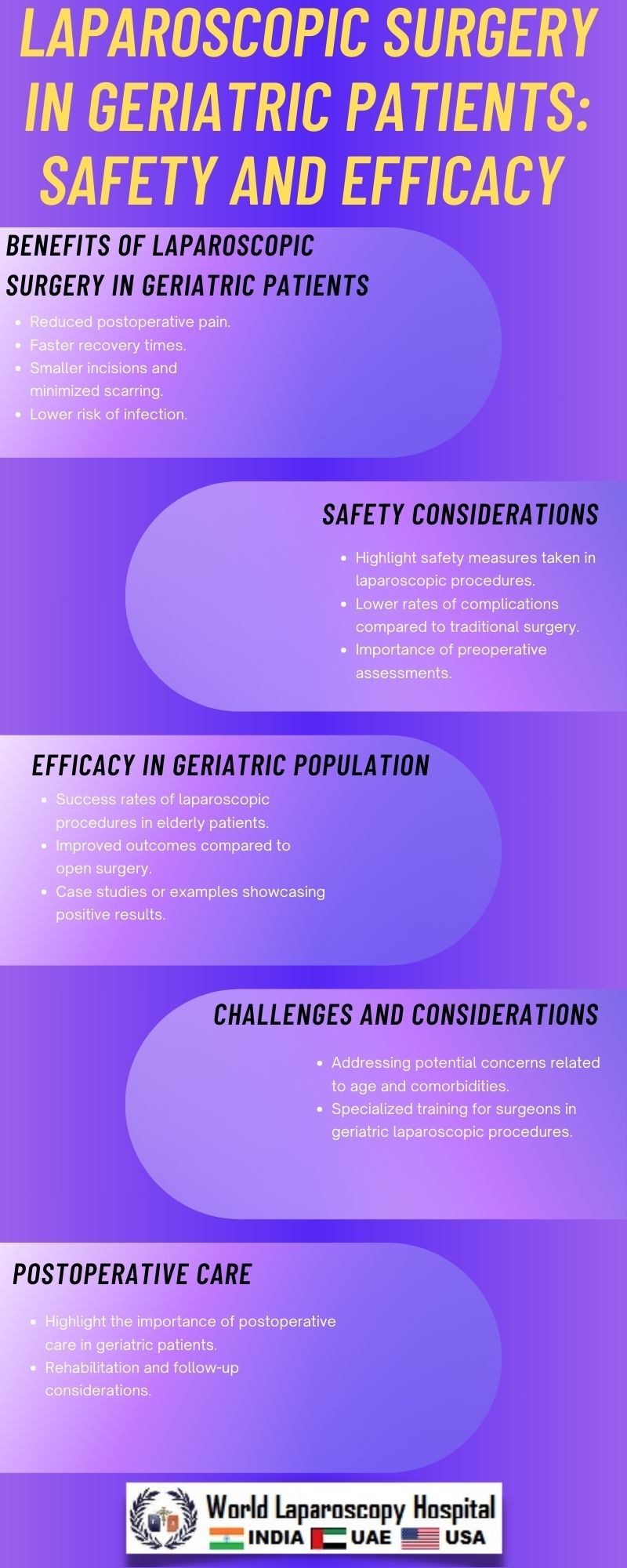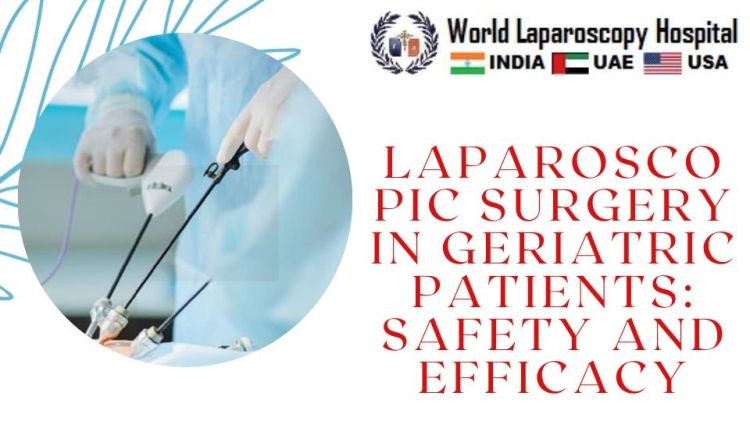Laparoscopic Surgery in Geriatric Patients: Safety and Efficacy
Title: Laparoscopic Surgery in Geriatric Patients: Safety and Efficacy
Introduction:
The global demographic landscape is undergoing a significant transformation with a growing population of elderly individuals. As life expectancy increases, so does the prevalence of age-related health issues, necessitating innovative approaches in healthcare. One such groundbreaking advancement is the application of laparoscopic surgery in geriatric patients. This article delves into the safety and efficacy of laparoscopic procedures in the elderly population, unraveling the complexities and dispelling common misconceptions.

The Aging Challenge:
The aging process brings about physiological changes that can pose challenges in traditional surgical approaches. Geriatric patients often have multiple comorbidities, reduced physiological reserves, and altered drug metabolism. These factors can complicate recovery and increase the risk of surgical complications. Laparoscopic surgery, also known as minimally invasive surgery, presents an alternative that minimizes trauma and enhances the recovery process.
Understanding Laparoscopic Surgery:
Laparoscopic surgery involves the use of small incisions through which a camera and specialized surgical instruments are inserted. The surgeon views the surgical site on a monitor and performs the procedure with precision. Compared to open surgery, laparoscopic procedures offer reduced blood loss, smaller scars, shorter hospital stays, and quicker recovery times. These benefits are particularly significant in the context of geriatric patients.
Safety in Geriatric Patients:
Reduced Blood Loss:
The minimally invasive nature of laparoscopic surgery contributes to reduced blood loss during procedures. This is crucial in geriatric patients who may have compromised cardiovascular systems.
Lower Infection Rates:
Smaller incisions decrease the risk of postoperative infections, a critical consideration in elderly patients with potentially weakened immune systems.
Shorter Hospital Stays:
Laparoscopic procedures generally result in shorter hospital stays, minimizing the risk of hospital-acquired infections and improving overall patient outcomes.
Preservation of Physiological Reserves:
Open surgeries can place a significant burden on a patient's physiological reserves. Laparoscopic surgery, by contrast, minimizes the stress on the body, making it a safer option for geriatric individuals.
Efficacy in Geriatric Patients:
Quicker Recovery:
Geriatric patients often face challenges in postoperative recovery. Laparoscopic surgery's minimally invasive nature allows for faster healing and a quicker return to normal activities.
Improved Pain Management:
Smaller incisions result in less postoperative pain, contributing to enhanced patient comfort and compliance with rehabilitation programs.
Enhanced Surgical Precision:
The magnified view provided by laparoscopic cameras allows surgeons to navigate anatomical structures with precision, reducing the risk of inadvertent damage during surgery.
Positive Impact on Quality of Life:
Rapid recovery and reduced postoperative complications contribute to an improved quality of life for geriatric patients undergoing laparoscopic procedures.
Addressing Concerns:
Despite the evident benefits, concerns have been raised about the application of laparoscopic surgery in the elderly population. Some argue that the physiological changes associated with aging may complicate the use of pneumoperitoneum (carbon dioxide insufflation), a key aspect of laparoscopic surgery. However, numerous studies have shown that with appropriate patient selection and careful monitoring, laparoscopic procedures can be safely conducted in geriatric patients.
Patient Selection and Preoperative Assessment:
The key to the success of laparoscopic surgery in geriatric patients lies in meticulous patient selection and thorough preoperative assessment. Comprehensive evaluations should consider a patient's overall health status, comorbidities, cognitive function, and social support systems. This personalized approach ensures that the benefits of laparoscopic surgery outweigh potential risks.
Case Studies and Research Findings:
Several studies have investigated the outcomes of laparoscopic surgery in geriatric patients across various surgical specialties. From cholecystectomy to colorectal procedures, research consistently demonstrates the safety and efficacy of laparoscopic techniques in the elderly population. The accumulated evidence highlights the adaptability of laparoscopic surgery to diverse clinical scenarios and reinforces its role in geriatric care.
Challenges and Future Directions:
While the advantages of laparoscopic surgery in geriatric patients are evident, challenges persist. Technical considerations, access to advanced surgical equipment, and the need for specialized training for healthcare professionals are areas that require attention. Additionally, ongoing research is vital to refine techniques and further optimize outcomes for this growing demographic.
Conclusion:
The integration of laparoscopic surgery into the healthcare landscape has revolutionized the way we approach surgical interventions, particularly in the context of geriatric patients. The safety and efficacy of laparoscopic procedures in the elderly population are supported by a robust body of evidence, challenging preconceptions and expanding the horizons of surgical possibilities. As we navigate the complexities of an aging world, embracing minimally invasive approaches like laparoscopic surgery is not merely a medical choice but a commitment to providing the best possible care for our golden generation.
Top
Introduction:
The global demographic landscape is undergoing a significant transformation with a growing population of elderly individuals. As life expectancy increases, so does the prevalence of age-related health issues, necessitating innovative approaches in healthcare. One such groundbreaking advancement is the application of laparoscopic surgery in geriatric patients. This article delves into the safety and efficacy of laparoscopic procedures in the elderly population, unraveling the complexities and dispelling common misconceptions.

The Aging Challenge:
The aging process brings about physiological changes that can pose challenges in traditional surgical approaches. Geriatric patients often have multiple comorbidities, reduced physiological reserves, and altered drug metabolism. These factors can complicate recovery and increase the risk of surgical complications. Laparoscopic surgery, also known as minimally invasive surgery, presents an alternative that minimizes trauma and enhances the recovery process.
Understanding Laparoscopic Surgery:
Laparoscopic surgery involves the use of small incisions through which a camera and specialized surgical instruments are inserted. The surgeon views the surgical site on a monitor and performs the procedure with precision. Compared to open surgery, laparoscopic procedures offer reduced blood loss, smaller scars, shorter hospital stays, and quicker recovery times. These benefits are particularly significant in the context of geriatric patients.
Safety in Geriatric Patients:
Reduced Blood Loss:
The minimally invasive nature of laparoscopic surgery contributes to reduced blood loss during procedures. This is crucial in geriatric patients who may have compromised cardiovascular systems.
Lower Infection Rates:
Smaller incisions decrease the risk of postoperative infections, a critical consideration in elderly patients with potentially weakened immune systems.
Shorter Hospital Stays:
Laparoscopic procedures generally result in shorter hospital stays, minimizing the risk of hospital-acquired infections and improving overall patient outcomes.
Preservation of Physiological Reserves:
Open surgeries can place a significant burden on a patient's physiological reserves. Laparoscopic surgery, by contrast, minimizes the stress on the body, making it a safer option for geriatric individuals.
Efficacy in Geriatric Patients:
Quicker Recovery:
Geriatric patients often face challenges in postoperative recovery. Laparoscopic surgery's minimally invasive nature allows for faster healing and a quicker return to normal activities.
Improved Pain Management:
Smaller incisions result in less postoperative pain, contributing to enhanced patient comfort and compliance with rehabilitation programs.
Enhanced Surgical Precision:
The magnified view provided by laparoscopic cameras allows surgeons to navigate anatomical structures with precision, reducing the risk of inadvertent damage during surgery.
Positive Impact on Quality of Life:
Rapid recovery and reduced postoperative complications contribute to an improved quality of life for geriatric patients undergoing laparoscopic procedures.
Addressing Concerns:
Despite the evident benefits, concerns have been raised about the application of laparoscopic surgery in the elderly population. Some argue that the physiological changes associated with aging may complicate the use of pneumoperitoneum (carbon dioxide insufflation), a key aspect of laparoscopic surgery. However, numerous studies have shown that with appropriate patient selection and careful monitoring, laparoscopic procedures can be safely conducted in geriatric patients.
Patient Selection and Preoperative Assessment:
The key to the success of laparoscopic surgery in geriatric patients lies in meticulous patient selection and thorough preoperative assessment. Comprehensive evaluations should consider a patient's overall health status, comorbidities, cognitive function, and social support systems. This personalized approach ensures that the benefits of laparoscopic surgery outweigh potential risks.
Case Studies and Research Findings:
Several studies have investigated the outcomes of laparoscopic surgery in geriatric patients across various surgical specialties. From cholecystectomy to colorectal procedures, research consistently demonstrates the safety and efficacy of laparoscopic techniques in the elderly population. The accumulated evidence highlights the adaptability of laparoscopic surgery to diverse clinical scenarios and reinforces its role in geriatric care.
Challenges and Future Directions:
While the advantages of laparoscopic surgery in geriatric patients are evident, challenges persist. Technical considerations, access to advanced surgical equipment, and the need for specialized training for healthcare professionals are areas that require attention. Additionally, ongoing research is vital to refine techniques and further optimize outcomes for this growing demographic.
Conclusion:
The integration of laparoscopic surgery into the healthcare landscape has revolutionized the way we approach surgical interventions, particularly in the context of geriatric patients. The safety and efficacy of laparoscopic procedures in the elderly population are supported by a robust body of evidence, challenging preconceptions and expanding the horizons of surgical possibilities. As we navigate the complexities of an aging world, embracing minimally invasive approaches like laparoscopic surgery is not merely a medical choice but a commitment to providing the best possible care for our golden generation.
